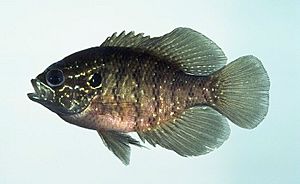Banded sunfish facts for kids
Quick facts for kids Banded sunfish |
|
|---|---|
 |
|
| Banded sunfish at the New England Aquarium | |
| Conservation status | |
| Scientific classification | |
| Synonyms | |
|
Pomotis obesus Girard, 1854 |
The banded sunfish (Enneacanthus obesus) is a cool freshwater fish. It belongs to a family of fish called Centrarchidae. These fish are quite small, usually growing to about 2 to 3 inches long. You can find them naturally in North America.
Contents
Meet the Banded Sunfish
The banded sunfish looks a lot like its cousin, the blackbanded sunfish. It has a body that is flat from side to side and quite tall. Its sides shine with many colors, like a rainbow, and are dark. You can see dark stripes, or bands, along its body. When it's time to mate, both male and female sunfish get tiny blue spots on their bodies.
Its mouth points upwards, and its fins, especially the ones near its chest and its tail, are round. This fish can grow to be about 9.5 centimeters (or 3.7 inches) long.
Where Do They Live?
Banded sunfish live in the eastern part of North America. You can find them in rivers and streams that flow into the Atlantic Ocean. Their home range stretches from southern Maine all the way down to central Florida. They also live along the Gulf coast, as far west as the Perdido River in Alabama.
Their Home Sweet Home
These fish love to live in quiet, calm waters. You can find them in small ponds or slow-moving parts of creeks and rivers. They also like boggy brooks. They prefer places with sand or mud at the bottom. The water they live in is usually a bit acidic, moves slowly, and has lots of plants.
What Do They Eat?
The banded sunfish is a small hunter! It mostly eats tiny water bugs, like insect larvae. It also enjoys eating very small crustaceans, which are like tiny shrimp.
How They Make Babies
Banded sunfish usually lay their eggs from April through July. They can start having babies when they are about one year old. The male sunfish builds a special nest in the sand or gravel. The female lays her eggs in this nest. However, the eggs float away from the nest, so the male doesn't guard them.
Their Status: Are They Safe?
The banded sunfish is facing some challenges in certain areas. It is considered an endangered species in states like Pennsylvania, New York, New Jersey, New Hampshire, and Connecticut. This means there are not many of them left in these places.
But if you look at their numbers worldwide, the banded sunfish population is doing well. The IUCN Red List, which tracks how safe animals are, lists them as a species of "Least Concern". This means they are not in immediate danger globally.
About Their Name
The banded sunfish was first officially described in 1854. A French fish expert named Charles Frédéric Girard gave it the name Pomotis obesus. He found them in Framingham and a branch of the Charles River in Holliston, Massachusetts.
The name Enneacanthus means "nine-spined," which refers to a feature on the fish. The second part of its scientific name, obesus, means "fat."


